The Baltics
The Baltic states – Estonia, Latvia and Lithuania – do not immediately come to mind when most people think of countries in Europe. And the Baltic states only became independent from Russia in 1991 so they are relatively new to the family of nations. Full disclosure, for the longest time I had trouble keeping the Baltics and the Balkans separated. But after crossing over from Russia and exploring Lahemaa National Park in northern Estonia we found ourselves in their fabulous ancient capital of Tallinn on the Gulf of Finland. And we loved it!
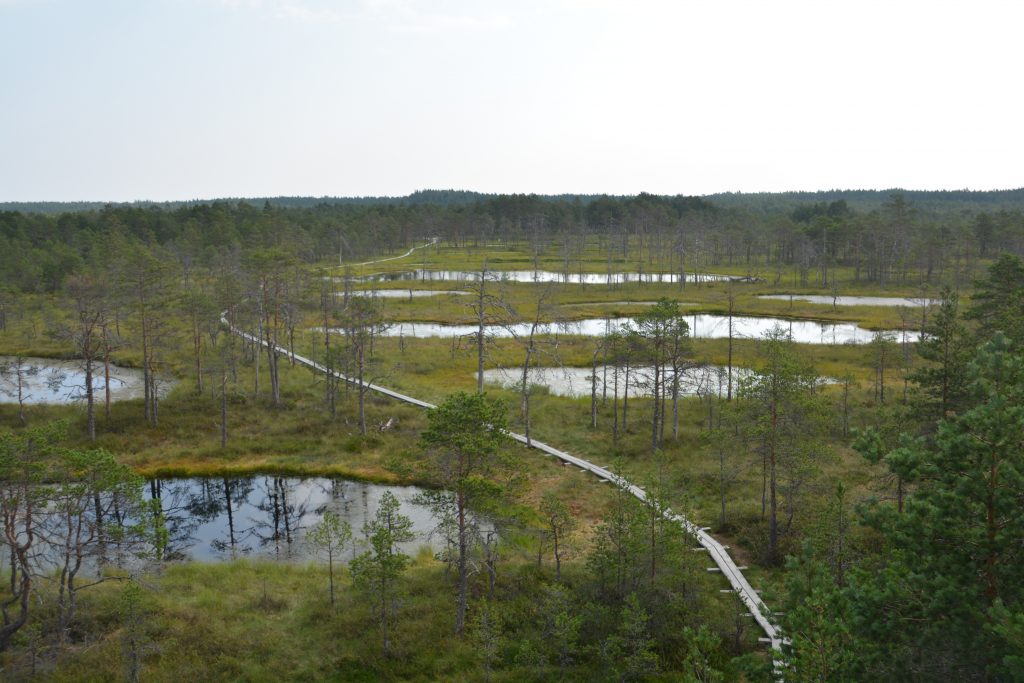
We explored some of the ‘beautiful bogs’ as they were described in the Lahemaa National Park before getting to Tallinn
Exploring the old historic town of Tallinn was like stepping back into the 15th century with its rough cobblestone streets, original town hall, numerous churches of different vintages and architectural design and its well-preserved high city walls. Many of the shops and restaurants even have their staff dress in medieval costume to add to the overall experience.
Tallinn is also at a fascinating crossroads between Europe, Eastern Europe and Scandinavia. We heard every language imaginable during our day exploring its historic sites and that is only fitting for a city that has been built up, lived in, sacked, rebuilt, destroyed, expanded and renovated by dozens of different invaders on a continuous basis during its thousand years of existence. And with their most recent occupier – the old Soviet Union – only leaving 37 years ago you have to hope this recent change lasts for a long time.
Estonia has dived head first into its membership of the EU and NATO. You can see the new-found prosperity in their buildings, roads, cars and people, a success story Europe can be proud of. But Estonia also has a complex past, including a brief independence between the world wars last century and its former invader and conqueror – Russia – just across the border.
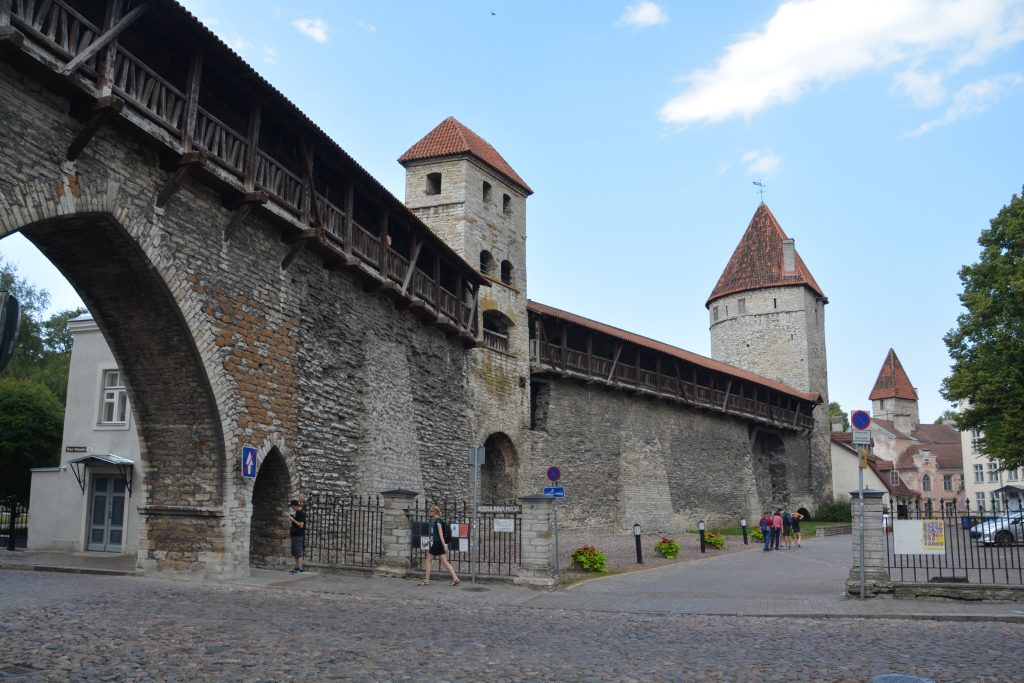
We walked the old city walls of Tallinn and climbed each of the towers for grand views of the city around it
Tallinn is a superstar city, that’s for sure, and their historic old town is a fascinating look into their colourful past. I particularly liked all the different architectural designs and features of the different churches in the city, depending on when it was built, who built it and for what denomination. Very cool.
The only downside to our visit to Tallinn was that it in peak tourist season it has become too popular – with four huge cruise ships in port and an international choir festival in town the streets and squares were absolutely packed with tourists. Sure, I know, everyone has a right to see this great city but we wanted it all to ourselves.
The next day we headed south through more gorgeous countryside, healthy fields of hay and wheat growing between groves of Scots Pines and Norway Spruce. We stopped at the seaside town of Parnu with its excellent deep sandy beaches and hordes of people soaking up the hot Estonian sun. We dipped our feet into the Gulf of Riga, as its called, and enjoyed watching the locals develop their tans.
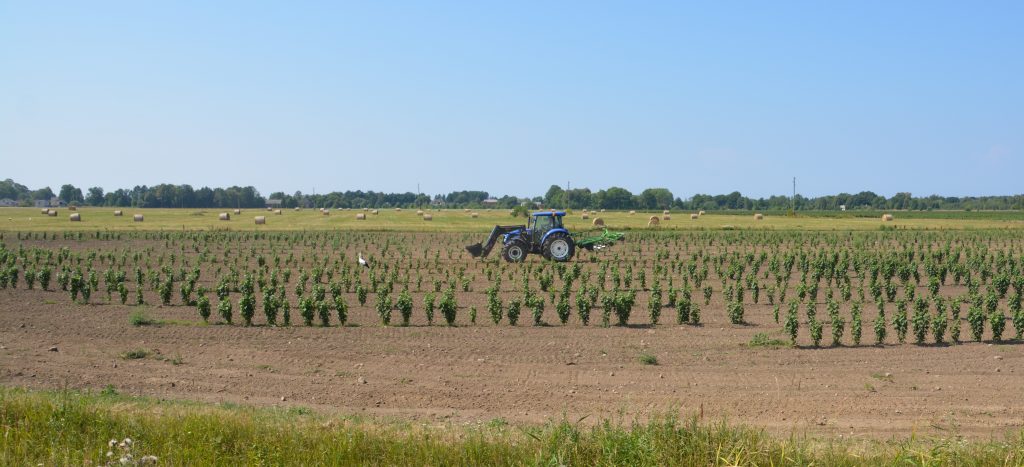
Tractors tractors everywhere – the countries of the Baltics, and particularly Estonia, seem to be reaping the benefits of being in the EU
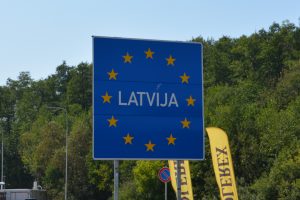
We entered Latvia – proudly showing their membership in the EU with the gold circular stars as part of their border sign
The 28 countries of the EU only police the external borders with non-EU countries so when you pass between EU members there is only a sign that signifies a change in sovereign nations. But in the case of crossing from Estonia to Latvia there is also a series of large stores that sell booze super cheap to thirsty Estonians (and the Finnish and many other nationalities). We couldn’t resist the temptation to stop and explore one of these alcohol superstores, maybe even buying a small amount for future use. And with good reason, it was the cheapest booze we had seen in Europe and only about one-third the cost of Australia.
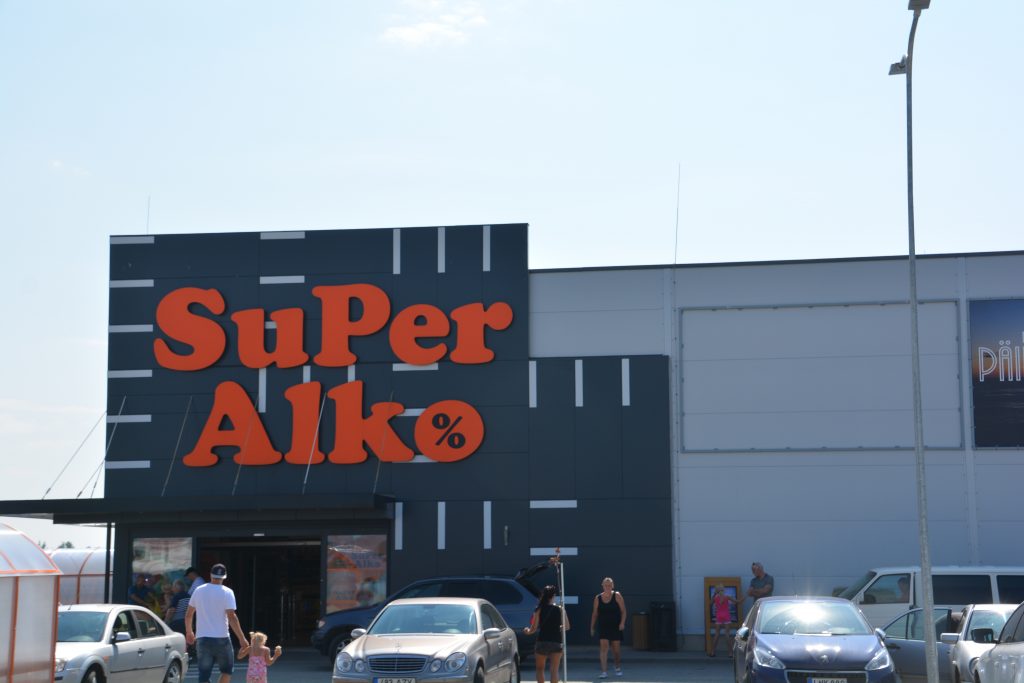
No confusion what this store is for after we crossed the border into Latvia – and of course we had to drop in to try the local products
Latvia’s story is similar to that of Estonia, invaded and ruled by many people over the centuries but proudly retaining its culture, language and aspirations to become independent. In 1991 they also broke away from the Soviet Union and have been steadily rebuilding themselves since. Latvia might be a little fuzzy on the edges compared to Estonia but it is still a growing and successful young nation.
We headed inland from the border and drove through some lovely Latvian countryside, large fields of hay and grain, quaint farm houses, many tractors out harvesting crops. We camped in Gaujas National Park on the banks of the Gauja River. The sun was hot, the trees tall and straight, the shallow sandy river full of kids splashing about, plenty of firewood and the beer was cheap. Bliss.
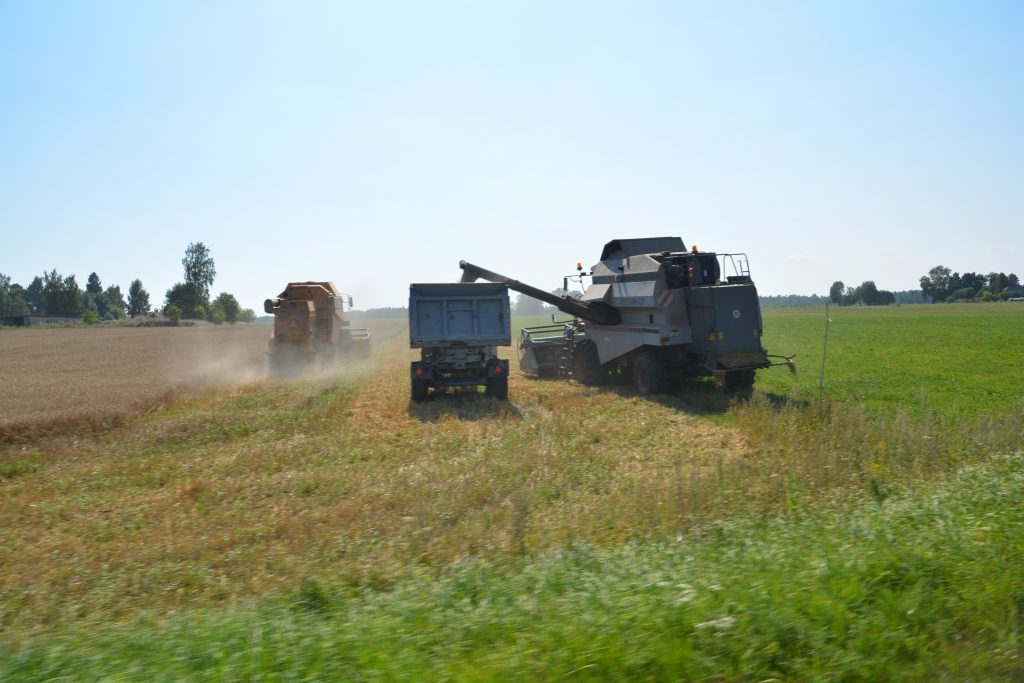
Its harvest time! You might think tractors and crops and harvesting are boring but at this time of year it is the main attraction around here.
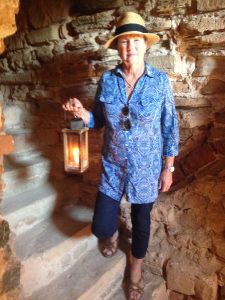
They gave us lanterns with candles in them to navigate the dark circular staircases of the old castle in Cesis
The historic town of Cesis was full of medieval surprises. The town features a 13th century church, very cool, and not one but two castles. The old castle is partly in ruins and is about 800 years old. A local in period costume gave us a candle-lit lantern to climb the dark and steep spiral staircase to the top of the tower. From there we could gaze down on the rest of the old castle, the new castle and the town itself. The new castle, new because it was built in the 18th century, was now mostly a museum but also had a tower and views.
We headed to Latvia’s capital, Riga, the only real city in the country and enjoyed the afternoon exploring the old town with its 200 and 300 year old buildings, cobblestone streets and original churches. Riga did not have the medieval sex appeal of Tallinn but it was still mighty impressive and with only one cruise ship in town it was relatively quiet.
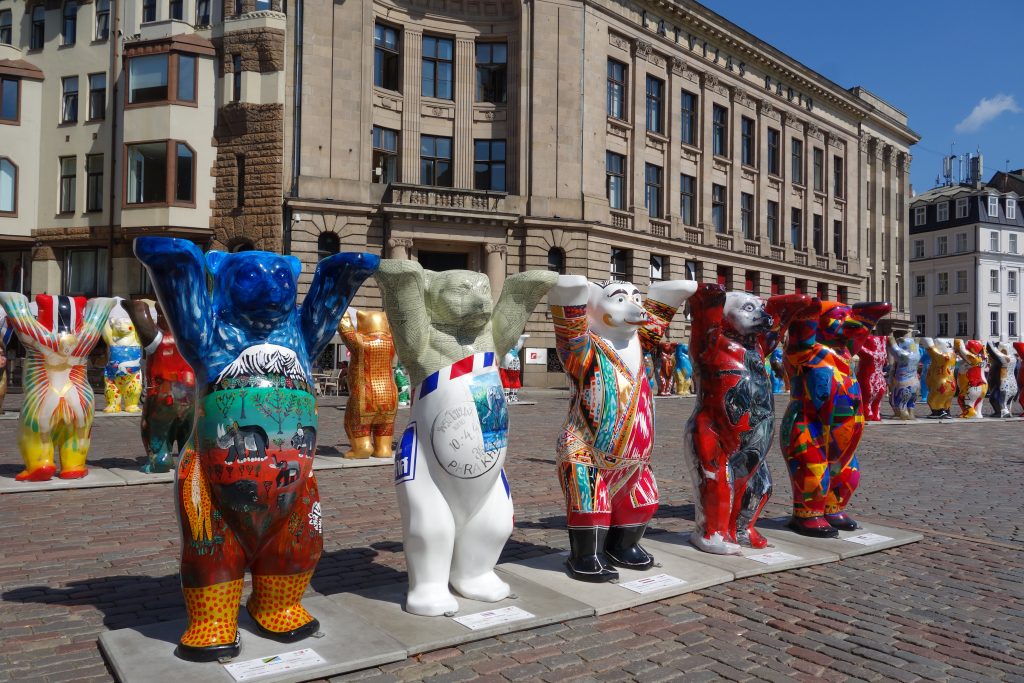
The main square of Riga featured these ‘buddy bears’ promoting world peace, one from each country painted in their national theme – very colourful and fun
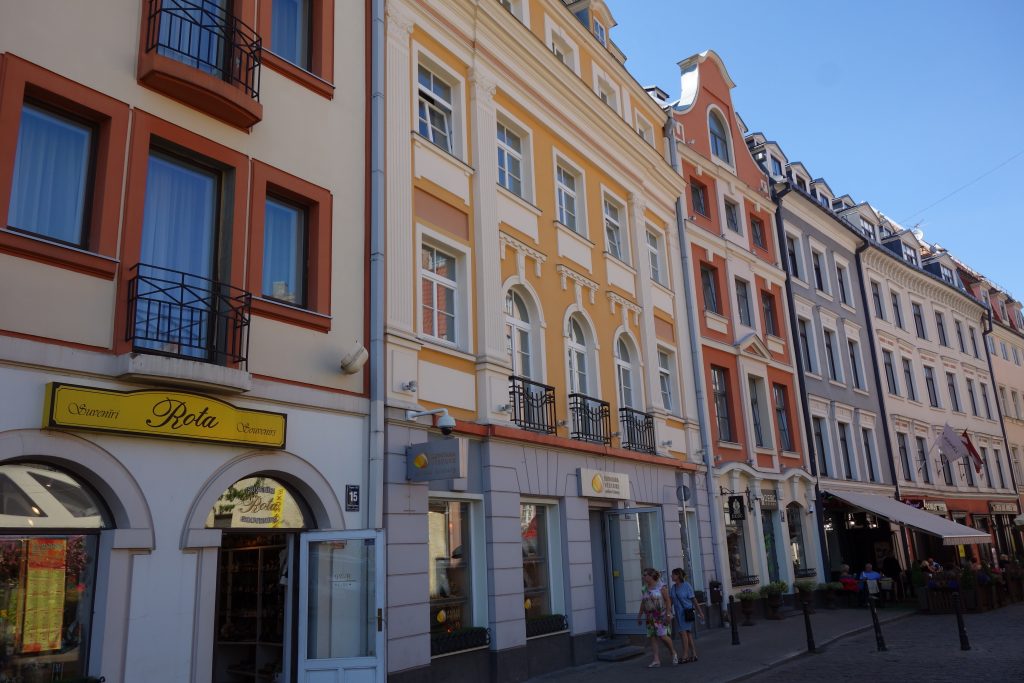
Like in many of these old cities, they’ve done a good job of preserving – or renovating – the old buildings
We drove down to the beachside town of Jurmala, famous during the Soviet days as a place where stressed-out communist officials came to relax and unwind in their gigantic summer homes. Today the homes are still there, most in very good condition, and the beaches were popular with the locals who were looking for that perfect Baltic tan. We camped that night on the grassy grounds of an old Soviet hotel, long since abandoned to its slow disintegration, only a four iron from the Gulf of Riga and the long deep beaches of Latvia.
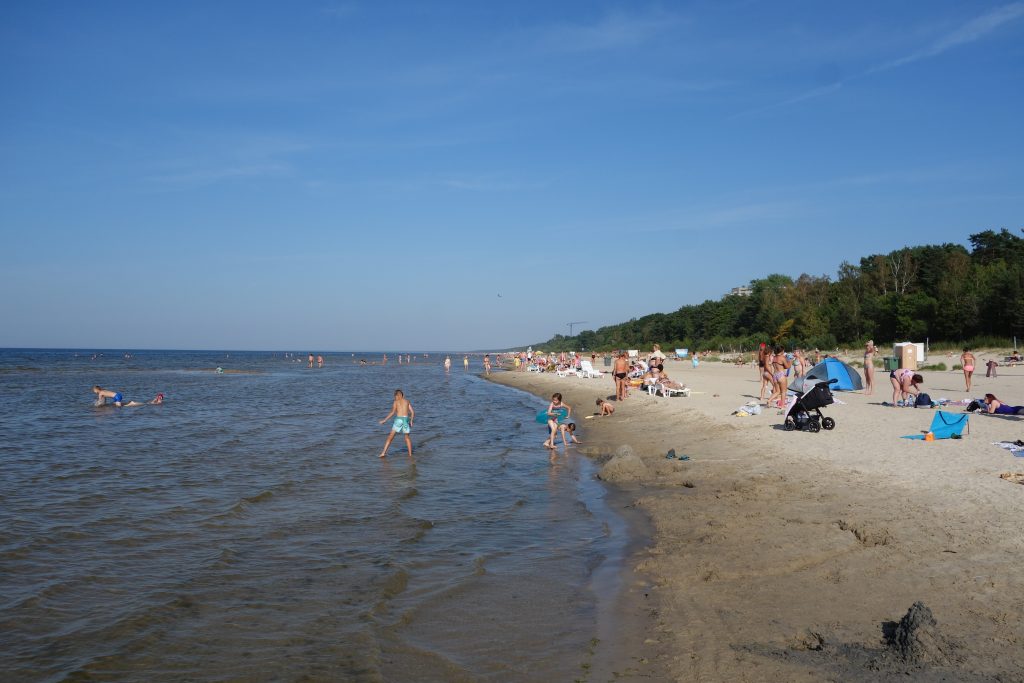
The beaches of Jurmala near Riga – not great but very popular with the locals in the stinking hot weather
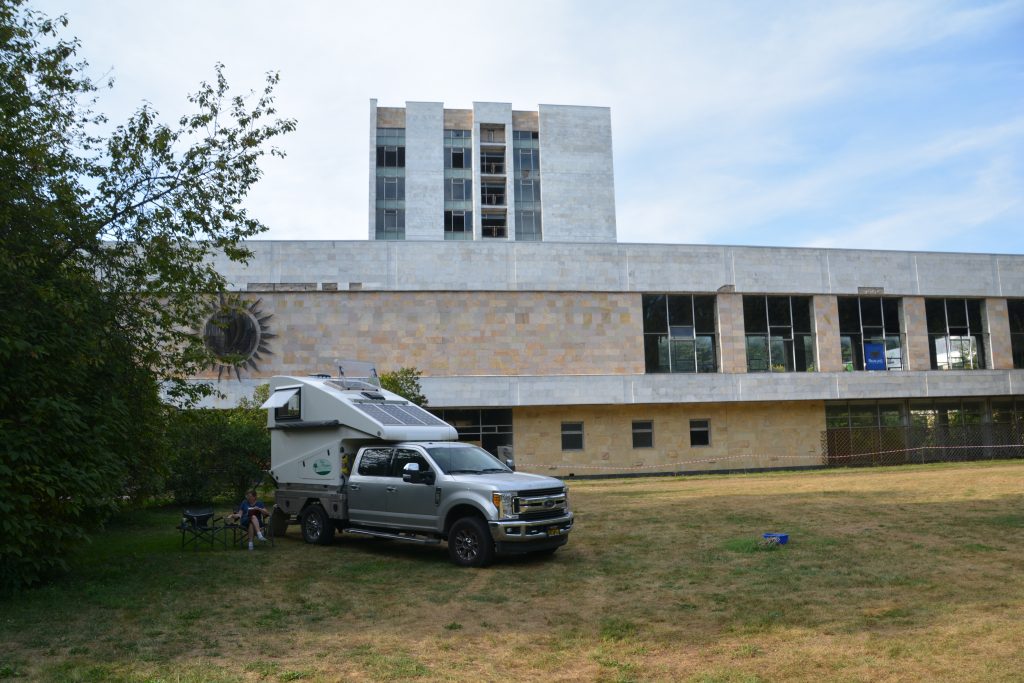
We’ve camped in a lot of amazing places but how about in the shadow of an old Soviet hotel, long since abandoned and crumbling apart
There was one more sight on our short list of things to do in Latvia and that was the Runsdale Palace which sits amongst the expansive wheat fields of southern Latvia. We enjoyed a beautiful drive along secondary roads, some of them gravel, through the fields and small towns along the way. Latvia definitely has signs of their Soviet occupation, mainly in the abandoned old cement buildings that are ever-present and the cooperative farming complexes that have been left to rust in the sunshine and snow.
The Runsdale Palace is a huge baroque palace built in the 18th century by the Duke of Courland but like many buildings in this part of the world it was passed back and forth between competing powers and has worn many hats. In addition to being a palace, Catherine the Great gave it to her lover’s brother, it was a military hospital for Napoleon’s troops, it was later converted to units for Latvian soldiers, it was a school for many years (the ballroom was converted to a gym) and then a museum. Renovation work was only completed in 2014.
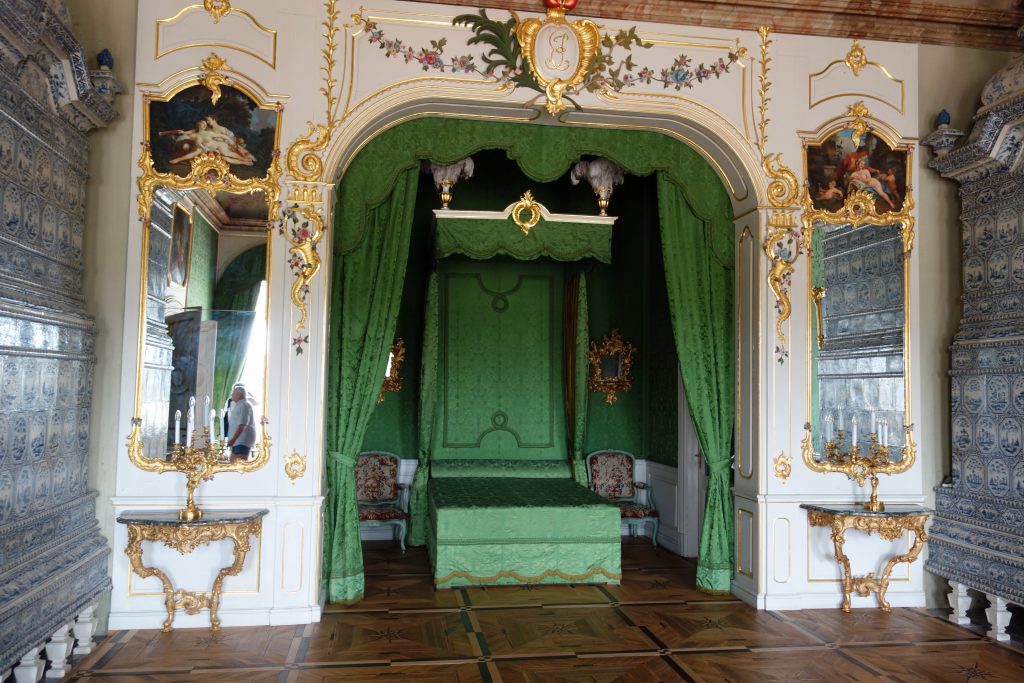
The Duke’s bedroom, maybe a bit odd but he’s the duke so he can do what he wants (especially in the bedroom)
Julie and I walked through the many rooms open to the public and then wandered around the impressive French gardens out the back. We’ve done a few palaces lately but this was a good one.
Then it was across the border into Lithuania, the last of the three Baltic States, with a similar history of prosperity, subjugation, occupation, independence, more occupation and finally more independence in 1991 from the shrinking Soviets. Today their language, flag and national pride fly high and their membership in NATO and the EU seem to be doing wonders for them.
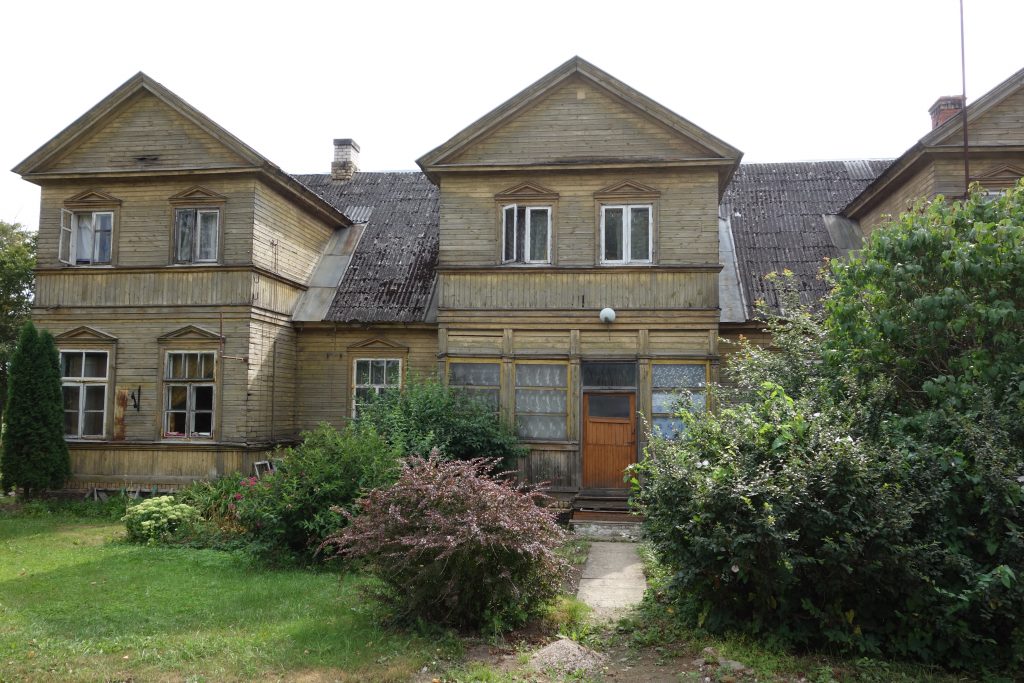
We loved some of the old farm houses in the rural areas – just imagine what stories these buildings could tell
Inside the Lithuanian borders we visited an extraordinary place, the Hill of Crosses, where up to 200,000 crosses have been planted to fulfil various religious and remembrance needs, a site even visited by the Pope. We walked amongst the crosses, some dating back a hundred years, others planted only last week, amazed at the quantity and the symbolism of the moment. Very different.
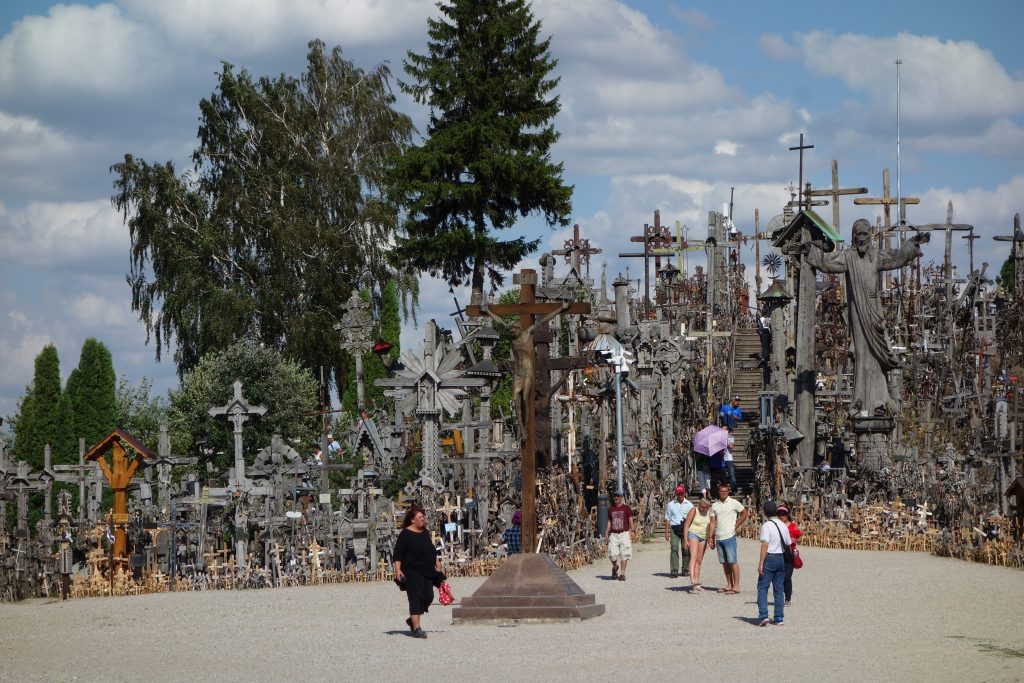
The Hill of Crosses – a whole lot of crosses all piled up together, kind of moving and kind of strange
We camped that night amongst the pine trees south of Saiuliai and the next day headed out to the Baltic Sea and the port town of Klaipedos. Our goal for the morning was the long finger of sand that runs south from the port all the way across the Russian border towards Kaliningrad. Called the Curonian Spit, it is a massive series of sand dunes reaching as high as 50 metres running parallel to the coast, today part national park and part beachside resort.
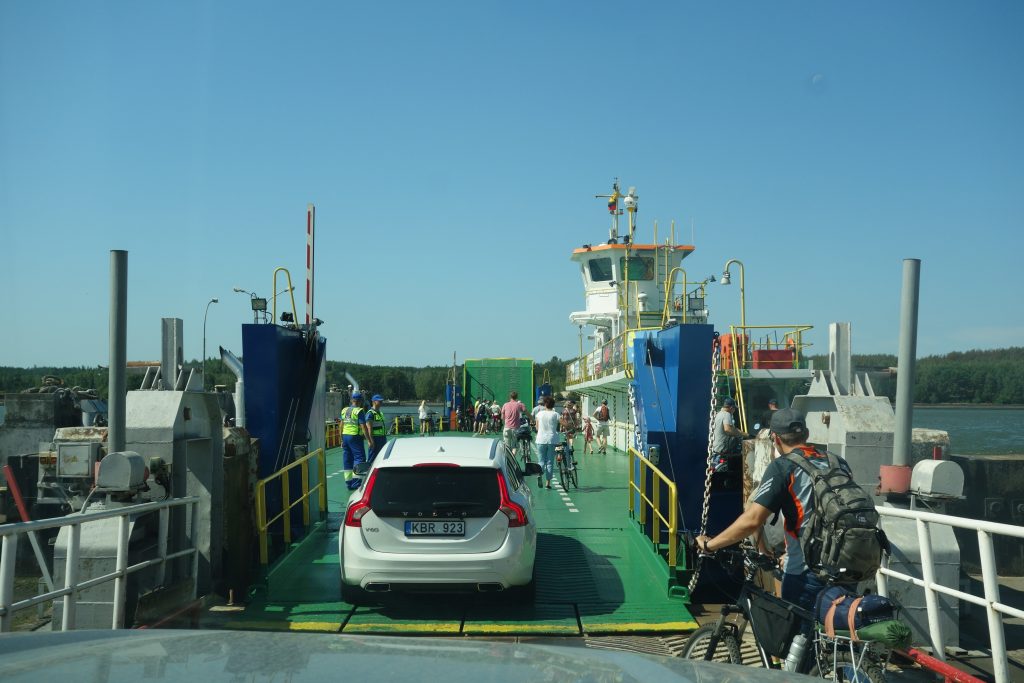
There was a massive queue of vehicles waiting to climb onto the ferry for the Curonion Spit – a big risk when we arrive on Saturday in peak summer season
Unfortunately we hit it on a hot Saturday morning which took the gloss off a bit. The queues to drive onto the ferry lasted more than an hour and the cost of the crossing was usurious but after parking and climbing the large sand dune over to the ocean side we found probably the best beach and surf we’d seen in Europe. Teeming with lobster-red Lithuanians, this place was perfect for those who want to soak up the short-summer sun and splash in the not-too-cold Baltic Sea. If we had the time we would have stayed for the day.
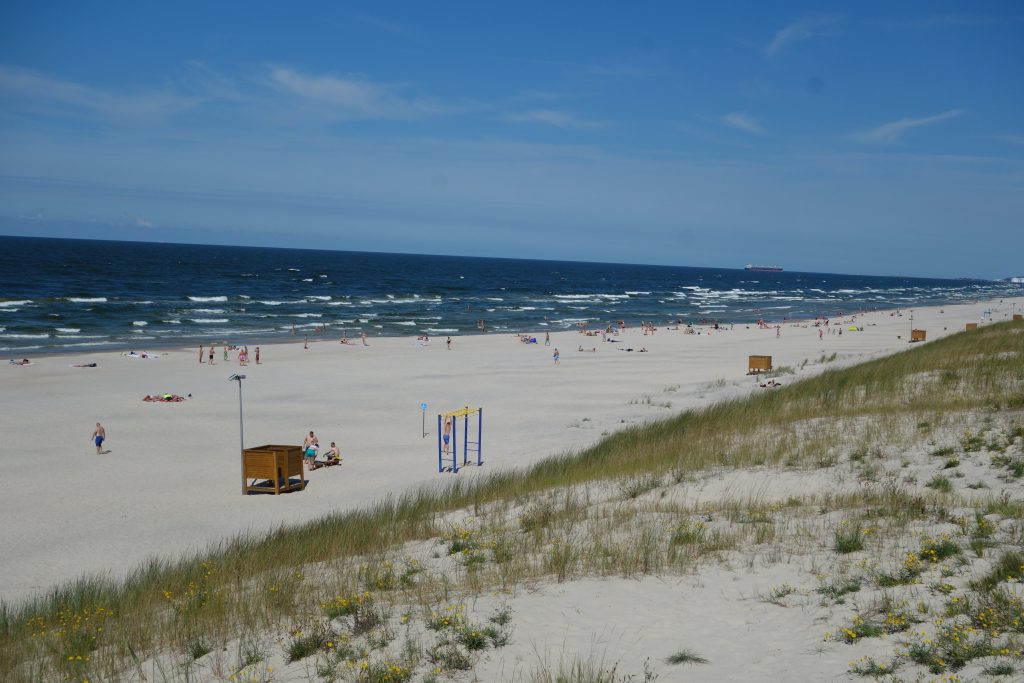
The Curonion Spit featured some of the best beaches we had seen in Europe – we wish we could have stayed awhile
Sadly the clock beat us and we were forced to drive eastward again through gorgeous green rolling fields of grain and hay to Lithuanian’s thriving capital of Vilnius. We camped that night at a campground near the airport which was perfect for us because the next day we were planning to break the piggy bank and break our pattern of travel by flying to a new country. But that’s another story.


















Comments
The Baltics — No Comments
HTML tags allowed in your comment: <a href="" title=""> <abbr title=""> <acronym title=""> <b> <blockquote cite=""> <cite> <code> <del datetime=""> <em> <i> <q cite=""> <s> <strike> <strong>